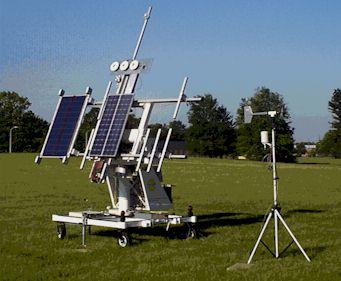Mobile Solar Tracker Facility

NIST's mobile solar tracking facility is used to characterize the electrical performance of photovoltaic panels. It incorporates meteorological instruments, a solar spectroradiometer, a data acquisition system, and a single-channel photovoltaic curve tracer. Precision spectral pyranometers are used to measure total (beam plus diffuse) solar radiation. Two instruments are used to provide redundant measurements. A pyrheliometer is used to measure the beam component of solar radiation. Long-wave radiation, greater than 3µ m, is measured using a precision infrared radiometer. A three-cup anemometer assembly is used to measure wind speed. The ambient temperature is measured using a perforated tip, Type-T thermocouple sensor enclosed in a naturally ventilated multi-plate radiation shield. The output signals of the meteorological instruments and thermocouples attached to the building integrated photovoltaic panels are measured using a data acquisition system. Spectral radiation data from 300 to 1100 nm is obtained using a spectroradiometer. The solar tracker's photovoltaic array tester measures and records the current and voltage (I-V) characteristics of the panels under evaluation. The array tester is capable of measuring panels or groups of panels with power outputs ranging from 10 watts to 36 kilowatts. Irradiance and temperature loads from a reference cell and thermocouple probe are recorded and used to normalize the data to user selected loads of irradiance and temperature. In addition to sweeping the panel I-V curve and storing the measured values, the curve tracer calculates the values of maximum output power, open circuit voltage, closed circuit current, and fill factor. The data acquisition system can accommodate up to 60 transducers.
Specifications/Capabilities
The mobile solar tracking facility can be operated in the following tracking modes:
- Azimuth and Elevation Tracking
- Azimuth Tracking
- Elevation Tracking
- Azimuth Tracking with User Selected Offset
- Elevation Tracking with User Selected Offset
- Fixed Position
Up to four photovoltaic modules can be mounted on the facility simultaneously. The facility can be operated over an azimuth range of ± 135° and over an elevation range from horizontal to vertical.
Usage Information
Access Information
This apparatus may be available for use by those outside NIST, but it must be operated by EL staff. Collaborative programs may be arranged on cost reimbursable basis.

